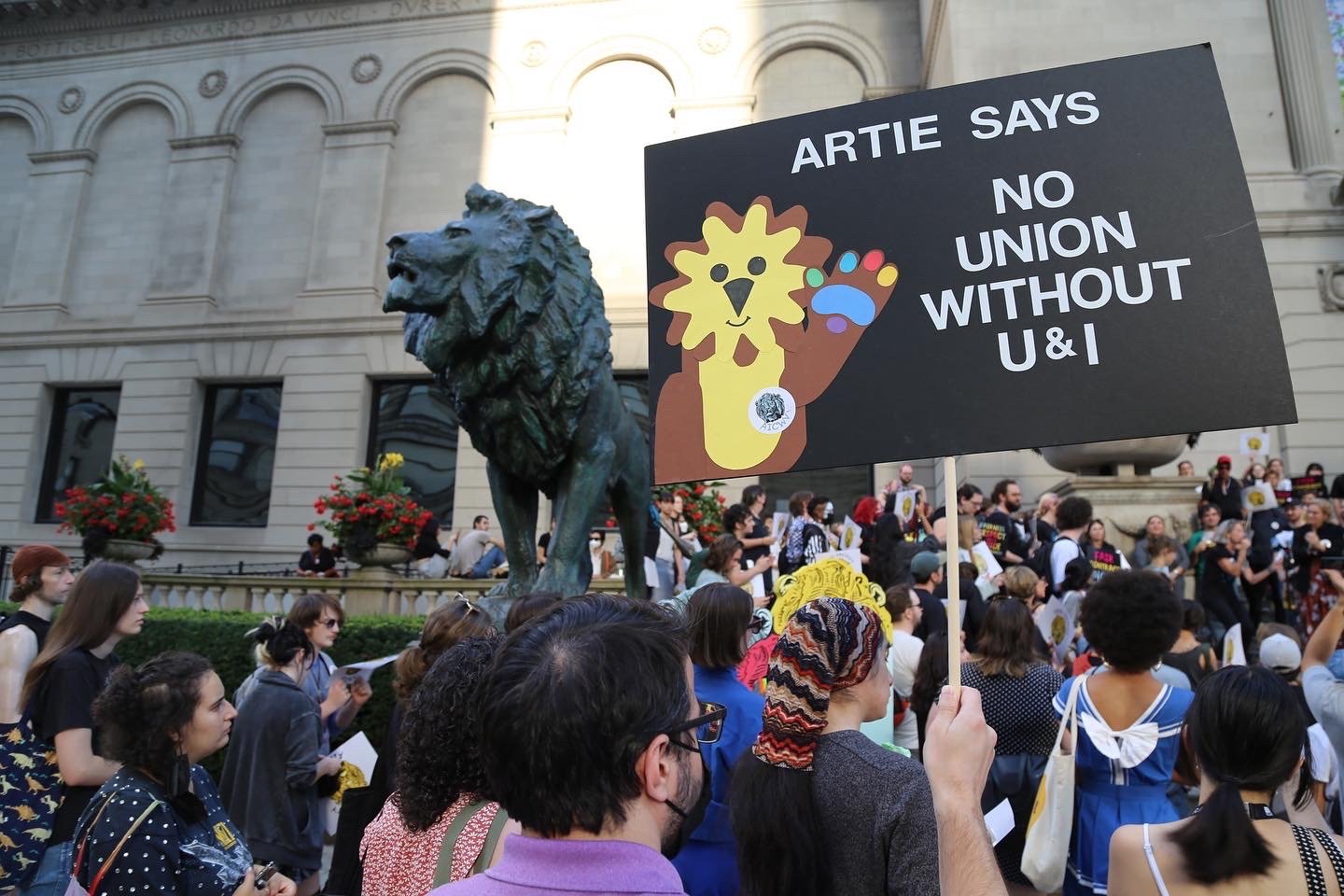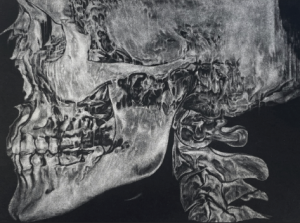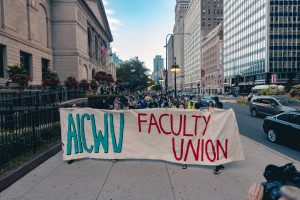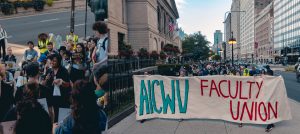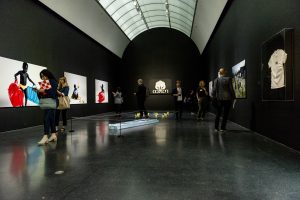The following is part of a series of interviews detailing the experiences of non-tenure track faculty at the School of the Art institute of Chicago before and during the fight to both join and expand the newly formed Art Institute of Chicago Workers United. The push for unionization began to accelerate during the height of the COVID-19 pandemic. Staff at the Art Institute and the School of the Art Institute were the first groups whose unionization was recognized by the National Labor Relations Board and AIC/SAIC administration; a win that occurred in January 2022. The staff of both AIC/SAIC voted to form a single bargaining unit at this time, which is what SAIC’s non-tenure track faculty are now fighting to join.
Since the non-tenure faculty filed for their union election with the National Labor Relations Board September 28th of this year, it is more important than ever to shine a light on the folx whose livelihoods, classrooms, students, families, health care, work, art practices, and very means of survival are affected by the union. Under capitalism, artists and arts practitioners are routinely cordoned off from the material resources, stability, and economic safety to create and teach. This series gives people fighting for dignity on the job, dignity in their work, and dignity as human beings in this world a platform to tell their stories.
Annette LePique: Can you introduce yourself and your relationship to SAIC/AIC to our reader?
Maggie Wong: Hi, I am Maggie Wong, a visual artist, artworker, educator, human, sibling, friend, you get the picture. Like many of my colleagues, I am a graduate of the SAIC, having completed my MFA in 2018 and additionally was a Museum Educator Graduate Scholar at the museum in 2017-2018. Prior to starting my first teaching job at SAIC I was a part-time teaching assistant for sketch classes at AIC in addition to designing and facilitating workshops and interactive learning spaces in the museum. I have been teaching at SAIC in the Contemporary Practices department as a Lecturer since 2019.
AL: How would you describe your working conditions?
MW: My labor as a lecturer is parceled out into bite-size chunks. I move between those chunks and in the gaps leak energy. It is not an energy-efficient system. I am making an unsustainable system of support and compensation “work.” Here is the basic structure: each summer I am given a year-long contract that caps my course load to three courses a year at a standard rate per course, unless I am given special approval by the Dean of Faculty to teach more. My lecture course rate when I started was $5,656. Now, four years later with inflation rampant, my course rate is $5,885. For that amount, I am expected to teach students materials, concepts, techniques, and research skills across disciplines that use 2D, 3D, and 4D (time-based) properties. I do this often with a co-teacher, sharing class sizes of up to 39 students, for 6 hours per week of in-person instruction, and 3 hours of prep weekly.
That time expectation would be sustainable if it were true. But for a new teacher, and even for more seasoned instructors, 3 hours of prep easily is spent on class admin, student meetings, and some prep. For me, and many others I know, the 3 hours fall into unpaid overtime of researching and creating multiple versions of course content that meets the unique needs of Gen Z, with their particular variety of anxiety, trauma, and Zoom-flavored learning gaps. On countless occasions I have talked with lecturer colleagues about the burning question, “Are we now untrained counselors?” And we ask this as student support such as counselors and advisors are overloaded by referrals and student need. Non-tenure track faculty — myself as an example — are learning new forms of care, crafting new ways to teach, burning out, and simultaneously being denied access to adequate mental and physical care through our employer. The only access to raises and health care is through a promotional process that has been on hold since 2020.
Beyond the limited access to better pay, time, and benefits, there are few formalized systems for supporting non-tenure-track teachers through mentorship. As academia is turning reflexively to stay relevant, including taking up critical initiatives for anti-racist pedagogy, faculty are doing the heavy lifting (alongside generous full-time leadership in my department) to facilitate these institutional learning moments. I keep feeling so ready for changes, but then question what is possible given how NTT, queer, disabled, and faculty of color have been practicing social justice and radical pedagogy for years, yet are relegated through the simple fact our work is demanding, under-compensated, and depleting.
But I am also lucky to work in a department that is full of faculty across ranks who informally, and often formally, exchange appreciation, and teaching materials, and relay validating stories that make me feel valued. My paycheck and contract do the opposite.
To get the income I need to live, make art, and get the care that I need, I work a few extra jobs doing art admin work for local spaces and piece together the peppered opportunities for one-time-payment gigs through SAIC. I routinely am a guest critique in English for International Students’ critique practice courses, have co-organized AAPI community events through my department’s Anti-Racism committee, have juried for the first-year exhibition, and later helped to install work for what is many first year’s first exhibitions ever. All these pieces of the pedagogical puzzle of service to the school are important to the health of a vibrant learning and diverse artistic community. I see myself and so many other colleagues leap to participate and crucially get paid for these service opportunities because we care, but also because the one-time payments we receive for these contributions can be the extra bit of cash needed to pay health care premiums, studio rent, purchase materials, or save up for winter/summer break.
AL: How has or how could the union change those conditions?
MW: I see the union helping to give non-tenure-track faculty a platform in which we share a legal backbone that gives us the strength to name what we already do and be equitably compensated for our labor. Stability — to make teaching feel that it is not another gig but recognize that it is a huge part of Chicago artists’ livelihoods. Non-tenure faculty make up the vibrancy of this city’s art community in that we are active artists who double down and support new waves of artists in this city. For many of us, myself included, teaching IS our work. It is fascinating, complex, and provides a community that is so necessary for our lives as artists. What the union can do is transform that community power into a collective body that articulates our working conditions with our own voice from the perspective of the classroom, studios, and fabrication spaces. From that bottom-up-built voice, we then hold the institution accountable to reflecting back our value and dedication through tangible and equitable resources.
MW: How does this unionization affect the future of arts work in Chicago?
Non-tenure-track teaching is like a watering hole that artists/writers/scholars come to visit or find some longer-term stays. What draws me to the watering hole is the community, paychecks, and the ability to be in intergenerational conversation including getting introduced to new materials and theories. This kind of energy and nourishment is what fuels not only individual practice but by natural extension constitutes an art community. Unionization is one tool that makes sure the watering hole has water we can actually drink. A fair contract is like a filtration system that can make sure all of our labor is compensated by a meaningful array of pay, mentorship, workload, benefits, and institutional accountability.
Why this watering hole is so important is that it rests inside a larger art world that produces scarcity of not just money but time and rest. In addition to covering the cost of rent, materials, tools, books, residencies, private health insurance, and mental health services, artists who also teach need access to the time it takes to process, plan, and endure. The scarcity of opportunities in the art world, the limited funding or security of classes in NTT teaching, and the rejection one face compound fatigue with the failures of larger support structures, even to the degree of earth’s ecological systems. No contract can relieve all existential anxieties, but equitable contracts are tangible outcomes of a mutually thriving community of lifelong learners, establishing equitable resource distribution, and operationalized solidarity.
AL: What does the union mean for you?
MW: After graduating, one of my many part-time jobs was working as staff in the Exhibitions department. My responsibilities were to be an art handler and guide undergrad student workers through hands-on learning about preparator work. Those student workers were extremely generous with sharing their experience of SAIC education as well as their hopes and anxieties about working as an artist and art worker. In 2019, in addition to working at the SAIC gallery, I started teaching in the Contemporary Practices department at SAIC, teaching first-year interdisciplinary studio courses. I would work three days a week at the gallery, workshopping my lesson plans with the student workers, and hearing candid tales of their school experience, while also imparting skills like how to install wall text or paint yet another layer of white. I then would turn around and teach a Saturday studio course from 9 to 4. Four years out and one pandemic deep into teaching those studio courses as a lecturer, I still feel deeply grateful to the mutual aid that happened in the midst of our labor. Those student workers who have since graduated are now my peers. And what I feel now is a weight of knowing that the teaching path they so encouraged me to pursue, and that is on their horizons as well, is a broken system of support for artists. What unionization means to me is the ability to have a concrete tool, called collective bargaining and fair contracts, that will be used to create systems of support and growth that schools claim to be — and these tools crucially are built by, for, and with the power of workers. Artists are workers, teachers are workers, and those who nurture are workers.
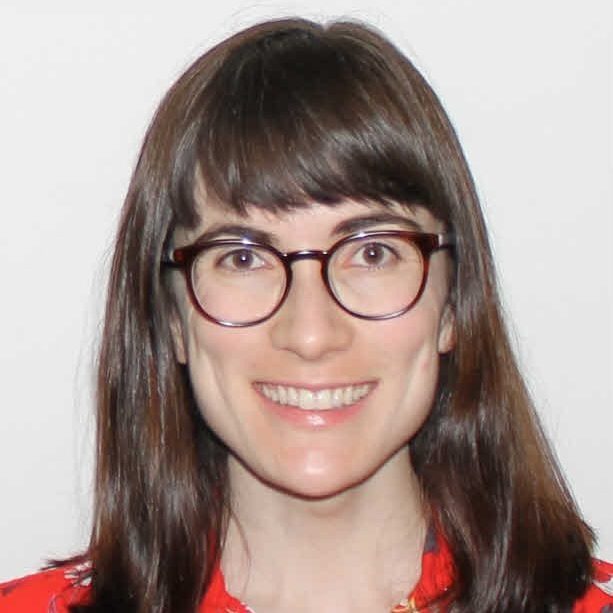
About the author: Annette LePique is an arts writer and Lacanian. Her interests include the moving image and jouissance. She has written for Newcity, ArtReview, Chicago Reader, Stillpoint Magazine, Spectator Film Journal, and others. She has a background in dance and music.
